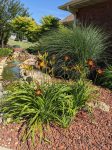I think that I shall never see, a poem lovely as a tree, wrote poet Joyce Kilmer in his poem Trees.
Trees add so much to the beauty of our city, yards and parks. They add value to our property and they have benefits which include cleaning the air, fighting air pollution and cooling down neighborhoods.
Planting trees on your property has positive effects on not only the environment but also your health.
A report released by the Nature Conservancy in 2016 showed the impact tree planting could have on health among 245 cities throughout the globe. The report said if $4 was spent per resident in the hottest, most-polluted cities in need of tree cover, tens of thousands of lives could be saved. The take-away from the report is that readers will get motivated to plant another tree in their backyard or encourage their city government to plant more trees along the street.
But if you don’t have a green thumb or have never planted a tree, where can you find information? Here’s some handy info to help you “branch” out and plant a tree or trees.
Nurseries
Doug Wagner, Jr., of Wagner Nursery in Asbury, Iowa, responded to the question of where to plant a tree.
“Many personal and logistical factors go into determining where to plant a tree,” he said. “The location is different for each home owner’s individual needs and wants.”
These factors include:
• Property size and grade of the land.
• Where the house is located on the property and if there is a scenic view the homeowner likes and wants to maintain.
• What types of trees are to be planted will determine location. Do you want a deciduous tree which sheds its leaves in the fall, or a coniferous tree which has needles and potentially messy pine cones?
• Will the tree receive enough light in the space you are considering?
• Think about how large the tree will grow in 10, 20, 30, 50 years. Avoid planting it too close to the house or property line.
• Determine the purpose of the tree, do you want the tree to shade the house for energy saving capabilities, or is there a spot in the yard that just needs the right tree?
Once you’ve chosen the site for your tree, next comes the planting. Wagner said the ground is comprised of clay almost everywhere you dig so special care must be taken to ensure the tree roots can expand.
• Dig the hole extra wide to give the roots plenty of room to start growing and expand.
• Planting a tree with the roots directly touching the thick hard dense clay will not allow the tree roots to grow which is bad for the tree. Back-fill the hole with the dirt you dug out of the hole mixed with soil amendments such as builder’s sand, compost, or manure, to help the tree get the best start possible.
• Never plant a new tree deeper than the graft that is on the tree trunk where it connects to the root stock.
• When planting a potted tree always cut the root ends clean through to stop and prevent the roots from spiraling around and around even after the tree is planted in the ground. This will cause root girdle if the roots are not cut at planting. This girdling left untreated eventually can kill the tree by self-suffocation.
• After installing a new tree, put a 4-inch deep mulch ring around the tree to help hold moisture in the ground. Do not allow the mulch to directly touch the tree trunk as this could cause trunk rot. The width of the mulch ring is dependent on how large the tree is.
Wagner the fourth generation owner/operator of Wagner Nursery also is a landscape designer.
Keeping the tree healthy is important so that it flourishes and grows. Wagner recommends:
• Installing fertilizer stakes into the ground around the drip line of the tree once per year, first thing in the spring.
• Treating for bugs, grubs, insects, diseases and molds once a year with an annual herbicide, fungicide or insecticide as a preventative measure.
• Certain trees like iron or acidity so adding that to the ground around the tree can be beneficial.
City of Dubuque
The City of Dubuque website has a link — www.cityofdubuque.org/452/Trees — that provides information about how to determine property lines so that you can avoid accidentally planting the tree on your neighbor’s property.
The website also details tree planting in the right-of-way which is the area between the curb and sidewalk. Property owners might not plant in the right-of-way, as any trees planted in this space must be chosen and planted by the Leisure Services Department. Property owners can request that the city plant a tree in front of their home if there is at least four-feet of grass area between the curb and sidewalk. Other factors including the location of utilities, stop signs and stop lights help determine if a tree can be planted in front of your property.
Dubuque has lost many trees to the Emerald Ash Borer, an invasive insect from Asia that attacks and destroys ash trees. It was first found in Michigan in 2002 and has spread into neighboring states, killing tens of millions of ash trees. The City of Dubuque website has information, including what to do to help prevent the spread of the insect. Visit www.cityofdubuque.org/1950/Emerald-Ash-Borer
City Forestry
The City Park Division has a Forestry Division, which is responsible for the maintenance of city trees located are on the public right-of-way, between street and sidewalk or on City of Dubuque property. The city forester will determine the health of a city tree to decide if it warrants removal or is a hazard to the public. The Forestry Division also is responsible for the cleanup of debris from a city tree. Contact the Park Division at 563-589-4263.
Jill Carlson is a freelance writer from Madison, Wis.











